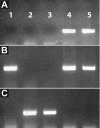Graft transmission of a floral stimulant derived from CONSTANS
- PMID: 15299137
- PMCID: PMC520796
- DOI: 10.1104/pp.104.040592
Graft transmission of a floral stimulant derived from CONSTANS
Abstract
Photoperiod in plants is perceived by leaves and in many species influences the transition to reproductive growth through long-distance signaling. CONSTANS (CO) is implicated as a mediator between photoperiod perception and the transition to flowering in Arabidopsis. To test the role of CO in long-distance signaling, CO was expressed from a promoter specific to the companion cells of the smallest veins of mature leaves. This expression in tissues at the inception of the phloem translocation stream was sufficient to accelerate flowering at the apical meristem under noninductive (short-day) conditions. Grafts that conjoined the vegetative stems of plants with different flower-timing phenotypes demonstrated that minor-vein expression of CO is able to substitute for photoperiod in generating a mobile flowering signal. Our results suggest that a CO-derived signal(s), or possibly CO itself, fits the definition of the hypothetical flowering stimulant, florigen.
Figures



References
-
- Becker D, Kemper E, Schell J, Masterson R (1992) New plant binary vectors with selectable markers located proximal to the left T-DNA border. Plant Mol Biol 20: 1195–1197 - PubMed
-
- Chiu WL, Niwa Y, Zeng W, Hirano T, Kobayashi H, Sheen J (1996) Engineered GFP as a vital reporter in plants. Curr Biol 6: 325–330 - PubMed
-
- Clough SJ, Bent AF (1998) Floral dip: a simplified method for Agrobacterium-mediated transformation of Arabidopsis thaliana. Plant J 16: 735–743 - PubMed
Publication types
MeSH terms
Substances
LinkOut - more resources
Full Text Sources
Other Literature Sources
Molecular Biology Databases

